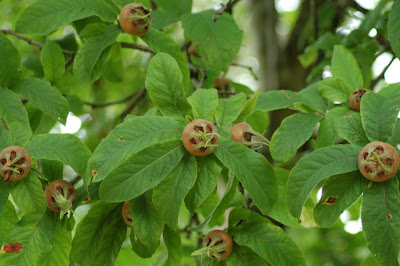Mespilus germanica

Common Medlar, Botanical Gardens, Copenhagen
The Common Medlar is a large shrub or small tree, and the name of the fruit of this tree. Despite its Latin name, which means German or Germanic Medlar, it is indigenous to southwest Asia and also southeastern Europe, mostly the Black Sea coasts of modern Turkey. The common medlar was cultivated ab. 3000 years ago in the Caspian Sea Region. It was introduced to Greece around 700 BC and to Rome ab 200 BC. By the 17th and 18th century, however, it had been superseded by other fruits, and is very rarely cultivated today.
Common Medlar is one of the few fruit that becomes edible in winter, and an important tree for gardeners who wish to try to have fruit available all year round. There are several cultivars, which bears the largest fruit. Medlar can be grafted on to the rootstock of another species fx pear and apple. It thrives best in warm sun and mild winters. The five-petalled white flowers turn up in late spring, and the leaves turn a spectacular red in the fall. The reddish-brown fruit is a pome with wide-spreading sepals which makes the fruit look hollow. In the beginning the fruit is hard and acidic, but edible after frost or storage. The skin wrinkles and turns dark brown, and the inside reminds about apple sauce, both in flavour and consistency. In the medieval kitchen the fruit was used for jelly and marmelade.
Until recently, the Common Medlar was the only known species of medlar. However, in 1990 a new species was discovered in North America, now named Stern's Medlar (Mespilus canescens). The Loquat (Eriobotrya japonica) is also related, and sometimes called the "Japanese Medlar".
In medicine common medlar was used as a means against diarrhoea and dysentery. The wood was used in the same way as pear wood for carved work , letter types, figures, fine furniture etc. - and furthermore the medlar wood gave good charcoal. The leaves and branches were used for tanning.
Botanical Gardens Copenhagen
photo september 2008: grethe bachmann
No comments:
Post a Comment